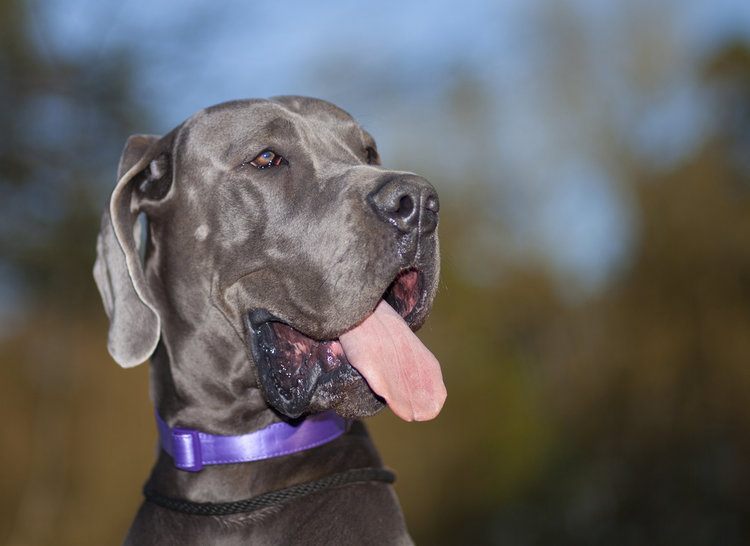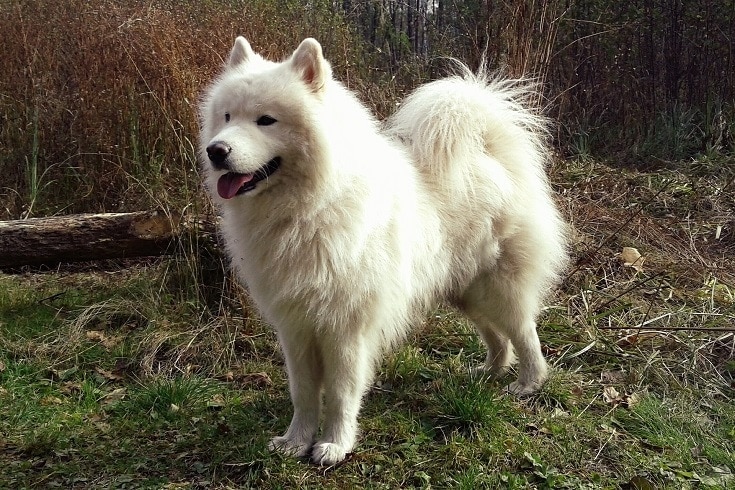How Much Should You Feed a Great Dane? Feeding Chart & Healthy Tips

Updated on

Click to Skip Ahead
Great Danes are big dogs. They eat a lot of food. However, feeding them the correct amount is also essential. You can’t just throw down a bunch of food and call it a day!
Because they are such big dogs and grow rapidly, they are prone to some joint problems. These can be further agitated by being overweight, as the extra weight will put more strain on their joints. The easiest way to avoid this is to ensure your puppy stays at a healthy weight, which can be done by feeding the appropriate amount of food.
In this article, we’ll do just that. We’ll start with some general guidelines based on age and then help you adjust the guidelines should you need to.
How Much to Feed a Great Dane Puppy – Feeding Chart
Important Note: Please note that while these tables list the average nutritional requirement of most dog breeds, Great Danes in particular usually have a considerably higher-than-average caloric requirement. We strongly advise consulting your veterinarian to ensure that your Great Dane puppy is getting proper amounts of nutrition.

You can also complement this guide by using our dog food calculator here:
The exact amount of calories an individual animal needs to maintain a healthy weight is variable and influenced by many factors including genetics, age, breed, and activity level. This tool is meant to be used only as a guideline for healthy individuals and does not substitute veterinary advice
What to Feed My Great Dane Puppy
When selecting a Great Dane puppy food, you need to ensure that the food is designed for giant breed puppies. Puppies that grow to huge adults, like Great Danes, grow more rapidly than other dogs. For this reason, they need specialized nutrition. Not all puppy food will be suitable for a Great Dane and may leave them with some nutritional deficiencies.
Be sure that any food you purchase is designed for giant breed puppies—not just large breeds. The food should also be high in protein.
When it comes to feeding dry, wet, or raw food, there truly isn’t that much of a difference. Wet and raw foods tend to have more meat and protein in them, making them better options for many puppies. However, it is possible to find similarly high-quality dry foods, so you can feed kibble if you’re set on that.
A suitable kibble for this breed is American Journey Chicken & Sweet Potato. Most importantly, it is designed for large and giant breed dogs. It is also grain-free and includes a lot of protein, including turkey and chicken. Meat products take up the first few ingredient slots. You also have the option to feed your dog fresh food, which is usually high-quality. Many dog food subscription services like Nom Nom Now offer fresh dog food.

Avoiding Underfeeding & Overfeeding
A puppy’s perceived hunger is not a good indication of whether they need to eat more. Some dogs are very food-driven, which means that they will do whatever they can to get more food. This makes them very easy to train, but it can confuse some owners. Just because your dog acts hungry doesn’t mean you should feed them more.
The best way to determine whether your puppy is getting enough food is to watch their body condition. You should be able to feel your dog’s ribs but not see them. They should have an obvious waist, though you shouldn’t be able to see their ribs.
If they look more “rounded,” then they are likely overweight. Simultaneously, if you can see more than the last rib, they may be underweight. Do not stress about putting muscle on growing puppies. They will have plenty of time for that when they’re older.

What to Switch from Puppy to Adult Food
Great Danes should be transitioned to adult food at about 18 months of age. This is rather late because these dogs continue growing rapidly for a long time, so it is important to continue the nutrient-dense puppy food. Otherwise, nutritional problems can develop.
You should start them on the adult food slowly. Replace 25% of the puppy’s food with the new adult food and then increase it by another 25% each day. For example, you should split the foods 50/50 on the second day. If the puppy develops digestive problems, keep the amounts the same for a few days until their symptoms improve and continue with the regimen.
Many dogs get sensitive when their food is switched. Because of this, it is essential to switch their food slowly and carefully. Otherwise, they may experience severe stomach upset and similar problems.

Why Won’t My Great Dane Puppy Eat?
Great Dane puppies can stop eating for a variety of reasons. The most problematic is a health problem. If your puppy’s stomach is upset or in pain, it may not have much of an appetite. Even minor problems can make puppies stop eating, as some dogs are more sensitive to pain than others. However, dogs can go for a surprisingly long time without eating, so usually not eating for a day isn’t something to worry about.
Another prevalent reason for appetite loss is stress. If you just brought your puppy home, this is likely what the issue is. Being in a new place can be very stressful, which can cause puppies not to eat. Their appetite should come back as they warm up to their new situation. Any change in the home can cause stress, even if it is minor. If you switch your routine or have visitors staying over, your puppy may stop eating because of stress. They should go back to eating after getting used to the new situation or after the thing causing the stress ends.
Sometimes puppies need a break from their nutrient-dense diet so they may eat less than usual for a few days. As long as they aren’t showing any signs of sickness, this is normal and nothing to be worried about.
The weather can also play a role. In scorching weather, dogs may not eat as much because they do more laying around. It is simply too hot to play hard! If your puppy has recently experienced a drop in exercise, they may reduce their caloric intake as well.
How Much to Feed an Adult Great Dane?
Great Danes are rather large, so they need quite a bit to eat. Their overall size will determine their consumption, as will their activity level. Pregnant females will need more food than non-pregnant females. You will likely have to change how much food your dog gets several times.
Don’t be scared to adjust your dog’s food intake. You may have your dog eating a lot at two years because of their activity level, but you may need to reduce it as they age and become more mellow.
Keep an eye on your dog’s body shape, as this will tell you a lot about their current weight. Once again, you should be able to feel a dog’s ribs but not see more ribs than the last one. They should have an obvious waist but plenty of padding between their ribs.
- Females: 6–8 cups a day
- Males: 7–10 cups a day
- Pregnant Females: Normal amount for the first four weeks; then switch to a puppy food and increase by about 15% to 25%
Generally, you do not need to increase a female’s food until they start showing that they are pregnant. You do not want them getting fat before you know for sure that they are pregnant, as this can throw off a false positive.
You will want to continue feeding your pregnant female this increased amount through her lactation period and for at least three months afterward. Even with the proper food increase, pregnant females will often lose weight while pregnant and feeding the puppies. She will need a bit of extra food to return to her original body weight.

Great Dane Feeding Guide for Seniors
While there are plenty of “senior” dog foods on the market, your senior dog does not need special food. The “senior” dog food distinction is not officially recognized, so there are no set guidelines for what senior dog food is. Your best bet is to usually leave them on the same quality adult dog food you’ve been using.
It is normal for senior dogs to decrease the amount of food they eat. Senior dogs often slow down and exercise less, so they will not need as many calories. If your senior dog slowly decreases the amount of food they eat, it is likely nothing to worry about. However, if your dog suddenly stops eating, then it may be time to call your vet. When dogs are older, there is always a chance of age-related health problems forming. It is important to get these taken care of quickly, so you should not overlook a sudden drop in appetite.
It is also somewhat normal for senior dogs to lose weight. A lot of this is a muscle, which they just aren’t using as much anymore. However, their body condition should not drop considerably.
Why is My Great Dane Always Hungry?
Many dogs are very food-driven. They can seem like they’re hungry all the time. Some dogs often scarf their food down. This does not give their stomach enough time to realize they are full, so they may still act like they are starving afterward.
For Great Dane puppies, in particular, it is essential not to overfeed them or free-feed them. If you provide your puppy with too much food, they will eat too many calories and grow too quickly. This will cause joint and bone development problems, leading to painful health conditions down the road. While you may be able to free-feed adult Great Danes, you should never do it with puppies.
If your dog seems to be eating their food too fast, you can try a slow feeder. These slow the dog’s eating down, allowing them to feel their fullness.
- Related read: pawTree Dog Food Review: Recalls, Pros & Cons
What Foods Are Bad for Great Danes?
There is no particular food that is bad for Great Danes. You should feed them food appropriate for their size as puppies, which means finding a dog food designed for giant breeds.
Besides this, any low-quality dog food that is bad for any dog will be bad for Great Danes. You should ensure that you select a high-quality dog food that is high in protein and fat. Choose dog foods with plenty of meat high on the ingredient list.

Conclusion
Great Danes need a lot of food to drive their fast growth. However, it is essential that you don’t feed them too much, as this can cause various health problems. Too many calories as a puppy can make them grow too fast, which may cause joint problems.
Follow our feeding guidelines carefully. You can adjust it based on your dog’s activity level and size. However, always keep an eye on their body condition to ensure they are getting the perfect amount of food.
See also: When to Switch a Great Dane From Puppy Food? Get to Know Your Dog
Featured Image Credit: Alicia Fdez, Shutterstock












